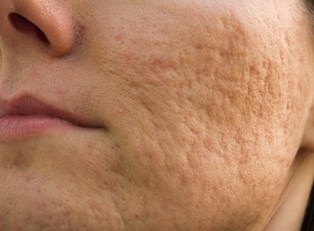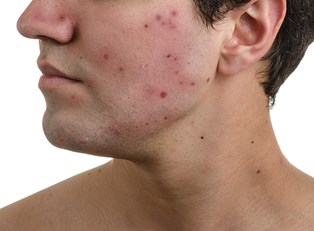Facial scars can be embarrassing and unsightly, even if you are the only one who notices them. While not every scar will disappear completely, the fibrous tissue that forms scars generally becomes less obvious with time. Here are a few tricks for helping scars heal more fully and more quickly.
Prevention
Of course, the easiest method for “healing” scars is to keep them from forming in the first place. If you have acne that tends to scar, leave it alone. Try not to pick or pop zits, and talk to your dermatologist about the best acne treatment for you to prevent new blemishes from forming. If injuries do occur, from acne or otherwise, treat them immediately -- whether that means getting prompt stitches or simply cleaning the area.
Avoid using hydrogen peroxide every day, as this not only dries out the skin, it kills new tissue that’s forming in addition to germs or necrotic skin cells. While it is healing, keep the area moist by applying triple antibiotic ointment, petroleum jelly, or a similar product. Applying vitamin E can help stimulate healing, and staying out of the sun can prevent discoloration. Then, allow the wound to heal -- without picking off the scab!
Home Remedies
If it’s too late for prevention (or you did your best, but wound up with a scar anyway), try cheaper, noninvasive home remedies. Scars that are deep or large may require more extensive measures, but smaller, milder scars -- such as those that result from acne, chicken pox, cuts, scrapes, and the like -- may clear up with just a little help from natural products. Some popular scar treatments include:
- Lemon juice: The alpha hydroxy acids in lemons are great for healing scars as well as helping your skin look and feel healthier. Plus, it’s natural tendency to bleach can help scars fade. Squeeze a little juice onto a cotton ball or q-tip and rub it onto the scar. Make sure to use the real thing, or you won’t get the same results.
- Aloe vera: Aloe vera isn’t just for soothing fresh burns -- it can help reduce scarring as well. No preparation is needed. Simply buy a plant, and break off a tiny piece each day. Rub the juices on your scar, and hope for the best!
- Oils: Coconut and olive oil are great for any skin, but especially useful for scarred areas. In addition to moistening the skin, both of these can be used as a diluting agent for essential oils that can help with scarring, such as tea tree or lavender. You can even mix it with lemon juice, if you find your skin too sensitive for juice undiluted.
More Intensive Measures
For larger scars, it may take a little more than juices and oils to reduce their appearance. Soft tissue fillers are a temporary option that fill the area under concave scars with fat or collagen. This puffs out the scar so it isn’t as obvious. Laser resurfacing involves using a light source to delicately remove layers of skin to make it look nicer and smoother. Similar procedures involve radio frequencies, and pulsing light sources to a similar effect; these therapies are also used for wrinkles and other facial blemishes.
Your dermatologist is a great source of information as to what the best options are for you. Talk to your doctor about other options like dermabrasions, chemical peels, or even surgery for serious scarring.




